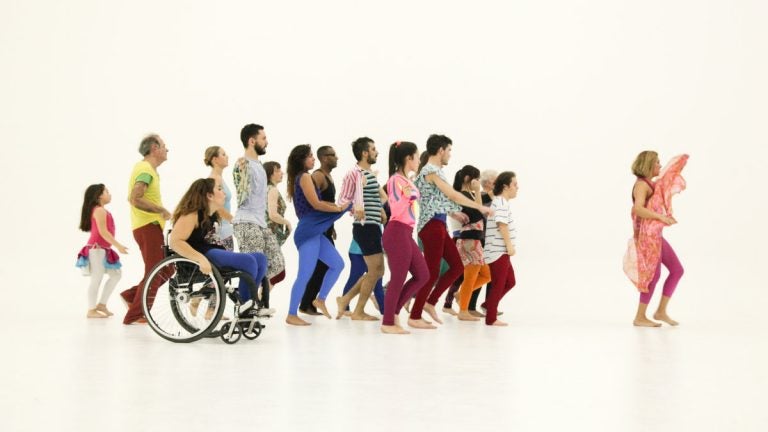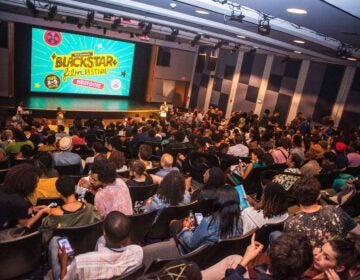All about this year’s Philly Fringe Festival, 20 years on

French choreographer Jérôme Bel's 'Gala
The Old City neighborhood was buzzing with anticipation 20 years ago this month. Philly performers and directors had invaded its empty spaces — vacant buildings were plentiful, unlike now — and they were going to put on a show. About 80 shows, in fact. This festival of unusual work was a free-for-all. If you wanted to put on a show and could find a space and (maybe) lighting and sound, join the fray.
Over the next two decades the arts festival, whose 20th version begins Friday with 55 performances and two art exhibits on opening day alone, came to be called the Philly Fringe. It blossomed. The annual festival, modeled after the huge one in Edinburgh, Scotland, marks the end of summer and is now hardly an event on the fringe. It’s a solid part of Philadelphia’s cultural life, with 65 major sponsors.
While it still offers people in odd spaces doing weird things, it also has people in traditional venues doing weird things. Plus not so weird. You’ll find a production of Eugène Ionesco’s “The Chairs,” and you’ll also find “Macbeth” – a co-presentation with Opera Philadelphia, set in the Democratic Republic of Congo. You can see John Patrick Shanley’s popular play “Doubt.” And you can witness a dance as unusual as “Levée Des Confits” a co-presentation with Drexel University in which two-dozen dancers from all over Europe morph from everyday gestures into complicated ones that dissolve and transform.
The artists come from here and all over in a festival coordinated by FringeArts in its own venue at the Delaware River. Some of it (14 shows and one exhibition) is curated by FringeArts — those selections are heavy with dance this time around. The bulk of it (167 shows) is still a free-for-all that anyone can join. Most of the shows are in and around Center City, but the Philly Fringe also occupies spaces in Chester (two shows) and Bryn Mawr (one show).
You don’t even have to go to the theater or pay for tickets to be part of the Fringe. Last year, FringeArts made headway with a free digital part of the festival – anyone can watch the digital shows on any device that connects to the Internet. This year, the Digital Fringe, as it’s called, offers 24 of them. Most go live when the festival opens Sept. 9.
That night – and every night at 10 during the festival – the Fringe becomes a scene when actors, directors, designers and audiences mingle at the FringeArts building and its inside and outside bars, at Race Street and Columbus Boulevard. The late-night parties are programmed with DJs, cabaret and other live music. You pay for whatever you drink, but the entertainment’s free.
The festival runs 16 days — the first Fringe was a five-day affair — and even after it’s over, FringeArts continues to program inside its own theater through the year, a dream that leader Nick Stuccio has realized and an answer to a recurring question from audiences over the years: Why is this thing limited to a couple weeks each year?
While that’s no longer the case, there’s nothing quite like the festival, with so many shows in so many places it’s as if the town is one big stage ready for, as Stuccio calls it, innovators who create “in many ways that make us look at the world anew, that make us re-examine what art is and what it means, and where it might go tomorrow.” These, he says, are adventurous people – and it’s a given that Fringe-goers are the same.
Here, in no particular order, is a sampling of shows in the festival. Some run throughout the 16 days, others only for a night. Of course, I can’t vouch for them – they haven’t yet been performed here. The shows curated by FringeArts are noted; all others are part of the general Fringe Festival. Click on the title of any show to go directly to the FringeArts site for that show, for more information.
For a full festival schedule on the Web, go to www.fringearts.com.
NOTES OF A NATIVE SONG. The first curated show to open – on Sept. 8, a night before the official festival begins – is a collaboration between Obie Award-winning Heidi Rodewald and the Tony Award-winning songwriter and performer called Stew, whose “Passing Strange” played on Broadway a few seasons back. Both are among the performers in this “concert novel,” which bills itself as a “high-energy blast of music, video and spoken word” that celebrates James Baldwin’s work and legacy.
CITIZEN, Reggie Wilson’s dance that considers the experience of being a citizen and belonging, officially opens the festival Sept. 9. The African Diaspora is a major focus of work by Wilson, whose dance this time around explores political and personal identity. This curated show is his third in the Philly Fringe.
THE ELEMENTARY SPACETIME SHOW is about a girl who attempts suicide but can’t quite die because she wakes up in a vaudevillian game show that she must win in order to die. Even so, it’s billed as up-tempo musical theater. The curated show is super-fringe high-concept, written and composed by César Alvarez, an artist-in-residence at the University of the Arts.
THE CHAIRS. It’s not everyday you get to see a production by Eugène Ionesco, and Philadelphia’s Idiopathic Ridiculopathy Consortium has come to specialize in the absurdist playwright’s work, an easy fit for a Fringe festival. This 1952 play – considered one of his best – starts off with a man and woman and expands to more characters (sort of), all moving into lots of chairs. But it’s much more than that.
PORTRAIT OF MYSELF AS MY FATHER. “She never knew her father, now she will invent him” is how the FringeArts description of dancer/choreographer and Zimbabwe native nora chipaumore (she uses no capitals) goes. And so she’s attempting to find the man as she dances, fiercely, inside a boxing ring with two other performers in this curated show.
GALA. French choreographer Jérôme Bel talks about the democratization of dance – he mixes trained dancers and non-dancers, or sometimes doesn’t – but for “Gala,” he will. Twenty of them will perform, professional dancers plus Philadelphians who include teens, children and seniors. When FringeArts asked Bel to explain how this dance performance was created, he responded that “this is a secret, this belongs to the performers, it cannot be shared.” People seem either to love Bel’s work or hate it – but they surely react. This curated show marks his fourth appearance in the Philly Fringe.
EXILE 2588, from Almanac Dance Circus Theater, is an “acrobatic, folk-music space epic” about Io, set 572 years in the future. Io is a moon of Jupiter, but who knows if that’s the Io we’re talking about? The live original music is by Chickabiddy. Pig Iron Theatre Company’s leader Dan Rothenberg has something to do with it, but no one’s defining just what. The mystery alone, plus the combo of break-dancing and trapeze work, makes this classic Fringe.
PANDAEMONIUM is from the Nichole Canuso Dance Company, with two superb artists –Canuso herself and Geoff Sobelle – exploring the desert landscape as they are alone on stage but together cinematically, compliments of Pablo N. Molina’s video design. Xander Duell’s music is played live. How does our digital culture affect our physical culture? “Pandaemonium” is an attempt to shed light on that dynamic. It’s among the curated shows.
GILBERT AND SULLIVAN’S SWITCHED! This G&S takeoff is also called “The Insider and the Outsider” and is performed by Tavern Productions and PAFA Performs, at the Pennsylvania Academy of the Fine Arts. The show’s setting, though, is the Union League, and the story promises to encompass themes of Black Lives Matter and the idea of entitlement. Plus a hooker with a heart of gold.
LE CARGO. Faustin Linyekula, called one of Africa’s most innovative choreographers and dancers by the BBC, considers the decades of war, terror and economic collapse in his native Congo – an area that’s now two countries, the Democratic Republic of the Congo and the Republic of the Congo. His dance about history, violence and memory is a curated show.
THE SINCERITY PROJECT (2016). This curated show is the second installment of a 24-year project in which a group of Philly-based performers examine their lives every two years. The first installment was curious and at times compelling, and left me wondering whether going through the lives of other people – as they go through their own – would be a solid enough concept to avoid their navel-gazing and hold our interest. “Time will tell” seems to be a theme of this theatrical experiment from Team Sunshine Performance Corporation and, in fact, time will tell.
I F— DARE YOU. The goofy locally-based Berserker Residents have several times provided a dark-horse hit of the Fringe Festival. Their latest comedy involves an audience-interactive meet-up with a lunatic prince and an English shut-in, who may be two sides of the same person from the looks of the group’s releases.
HABITUS. The Fabric Workshop organized this curated installation on Pier 9 along the Delaware River, where artist Ann Hamilton has created an interior landscape that you can manipulate. Hamilton is interested in architecture and social history and creates large-scale installations. According to FringeArts folks, she says this one shows the connection “between text and textiles.” It runs well past the festival, through Oct. 10.
ANIMAL FARM TO TABLE. The city’s Renegade Company has done well at the Fringe before, and this time they’re performing a “new kind of dinner theater” based on George Orwell’s “Animal Farm.” The show, at the Urban Creators Farm in North Philadelphia, culminates in a community-created meal.
FEED. Applied Mechanics, another Philly-based group that’s made a mark at the Fringe, also has a show about food – a cast of three in “a play you can eat,” they say. The option that food spurs on rituals for communing with the dead is somehow a part of it.
ROOM 21. Who knew that the great collector of art and objects, Albert Barnes, was also a record buff? Composer Jace Clayton – he’s also known as DJ/rupture – performs his concert composition that recognizes this and celebrates the mixed modes and cultures side by side in his displays. Clayton’s joined by the Prometheus Chamber Orchestra and several artists in this curated show. For more about the way Barnes used his records to accompany his lectures on art, see Peter Crimmins’ story on NewsWorks: http://ow.ly/V1GY303WBXA
JULIUS CAESAR. SPARED PARTS is from the controversial theater artist Romeo Castellucci, his third curated show at the Fringe. It’s his re-envisioned 1997 production that offers monologues he calls a “dramatic intervention” on Shakespeare’s “Julius Caesar.” One is delivered by an actor who speaks only through gestures, another (Mark Antony’s funeral oration) by an actor who has no vocal chords, and a dialogue on the state of Rome comes from an actor whose vocal chords we can see in real time.
WHYY is your source for fact-based, in-depth journalism and information. As a nonprofit organization, we rely on financial support from readers like you. Please give today.




